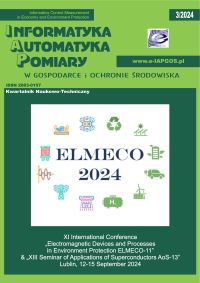METODY POMIARU SPRZĘŻENIA MAGNETOELEKTRYCZNEGO W MATERIAŁACH MULTIFERROICZNYCH
Jakub Grotel
j.grotel@pollub.plPolitechnika Lubelska, Wydział Elektrotechniki i Informatyki (Polska)
http://orcid.org/0000-0001-8428-2292
Abstrakt
Magnetoelektryczne multiferroiki należą do grupy materiałów, które wykazują sprzężenie pomiędzy uprządkowaniem ferroelektrycznym a magnetycznym. Zjawisko to nosi nazwę sprzężenia magnetoelektrycznego (ME). Multiferroiki posiadają szereg potencjalnych zastosowań w takich dziedzinach jak metrologia, elektronika, pozyskiwanie i konwersja energii czy medycyna. Badania nad multiferroikami stoją przed dwoma głównymi wyzwaniami. Po pierwsze, naukowcy nieustannie próbują uzyskać materiał o wystarczająco silnym sprzężeniu ME w temperaturze pokojowej, który umożliwiłby jego komercyjne zastosowanie. Po drugie, techniki pomiarowe stosowane w badaniach multiferroików są często problematyczne we wdrażaniu ich w warunkach laboratoryjnych i nie umożliwiają otrzymania powtarzalnych wyników. Celem niniejszej pracy jest omówienie trzech najczęściej stosowanych metod w badaniach nad multiferroikami; techniki lock-in, mostka Sawyera-Towera (S-T) i pomiarów stałej dielektrycznej. Artykuł rozpoczyna się od ogólnego opisu multiferroików, po którym następuje matematyczne przedstawienie efektu ME. W głównej części omówiono wyżej wymienione techniki pomiarowe. Artykuł zamyka podsumowanie i perspektywy przyszłych badań.
Słowa kluczowe:
multiferroiki, efekt magnetoelektryczny, mostek Sawyera-Towera, magnetopojemnośćBibliografia
Bain A. K., Chand P.: Ferroelectrics: Principles and Applications. Wiley, 2017
DOI: https://doi.org/10.1002/9783527805310
Google Scholar
Bonaedy T, Koo Y. S., Sung K. D., Jung J. H.: Resistive magnetodielectric property of polycrystalline γ-Fe2O3. Applied Physics Letters 91(13)/2007, 132901 [http://doi.org/10.1063/1.2790474].
DOI: https://doi.org/10.1063/1.2790474
Google Scholar
Catalan G.: Magnetocapacitance without magnetoelectric coupling. Applied Physics Letters 88(10)/2006, 102902 [http://doi.org/10.1063/1.2177543].
DOI: https://doi.org/10.1063/1.2177543
Google Scholar
Cheong S.-W., Mostovoy M.: Multiferroics: a magnetic twist for ferroelectricity. Nature Materials 6(1)/2007, 13–20 [http://doi.org/10.1038/nmat1804].
DOI: https://doi.org/10.1038/nmat1804
Google Scholar
Das C., Shahee A., Lalla N., Shripathi T.: A simple and low cost Sawyer-Tower ferro-electric loop tracer with variable frequency and compensation circuit. Proceedings of the 54th DAE Solid State Physics Symposium, 2009, 439.
Google Scholar
Dawber M., Rabe K. M, Scott J. F.: Physics of thin-film ferroelectric oxides. Reviews of Modern Physics 77(4)/2005, 1083 [http://doi.org/10.1103/RevModPhys.77.1083].
DOI: https://doi.org/10.1103/RevModPhys.77.1083
Google Scholar
Duong G. V., Groessinger R., Schoenhart M., Bueno-Basques D.: The lock-in technique for studying magnetoelectric effect. Journal of Magnetism and Magnetic Materials 316(2)/2007, 390-393 [http://doi.org/10.1016/j.jmmm.2007.03.185].
DOI: https://doi.org/10.1016/j.jmmm.2007.03.185
Google Scholar
Eerenstein W., Mathur N. D., Scott J. F.: Multiferroic and magnetoelectric materials. Nature (7104)/2006, 759–765 [http://doi.org/10.1038/nature05023].
DOI: https://doi.org/10.1038/nature05023
Google Scholar
Fiebig M., Lottermoser T., Meier D., Trassin M.: The evolution of multiferroics. Nature Reviews Materials 1/2016, 16046 [http://doi.org/10.1038/natrevmats.2016.46].
DOI: https://doi.org/10.1038/natrevmats.2016.46
Google Scholar
Fiebig M.: Revival of the magnetoelectric effect. Journal of Physics D: Applied Physics 38(8)/2005, R123 [http://doi.org/10.1088/0022-3727/38/8/R01].
DOI: https://doi.org/10.1088/0022-3727/38/8/R01
Google Scholar
Fuentes-Cobas L. E., Matutes-Aquino J. A., Fuentes-Montero M. E.: Handbook of Magnetic Materials, Chapter 3- Magnetoelectricity. Elsevier, 2011
DOI: https://doi.org/10.1016/B978-0-444-53780-5.00003-X
Google Scholar
Guobin C., Hui Y., Xiaoming Z., Jun L., Jun T.: Clarification of the Magnetocapacitance Mechanism for Fe3O4-PDMS Nanocomposites. Journal of Nanomaterials 2015/2015, 982174 [http://doi.org/10.1155/2015/982174].
DOI: https://doi.org/10.1155/2015/982174
Google Scholar
Hishiyama Y., Kaburagi Y., Inagaki M.: Materials Science and Engineering of Carbon: Characterization. Elsevier, 2016
Google Scholar
Khomskii D.: Classifying Multiferroics: Mechanisms and Effects. Physics 2/2009 [http://doi.org/10.1103/Physics.2.20].
DOI: https://doi.org/10.1103/Physics.2.20
Google Scholar
Kimura T.: Magnetoelectric Hexaferrites. Annual Review of Condensed Matter Physics 3(1)/2012, 93–110 [http://doi.org/10.1146/annurev-conmatphys-020911-125101].
DOI: https://doi.org/10.1146/annurev-conmatphys-020911-125101
Google Scholar
Kitagawa Y., Hiraoka Y., Honda T., Ishikura T., Nakamura H., Kimura T.: Low-field magnetoelectric effect at room temperature. Nature Materials 9(10)/2010, 797–802 [http://doi.org/10.1038/nmat2826].
DOI: https://doi.org/10.1038/nmat2826
Google Scholar
Kreisel J., Kenzelmann M.: Multiferroics – the challenge of coupling magnetism and ferroelectricity. Europhysics News 40(5)/2009, 17–20 [http://doi.org/10.1051/epn/2009702].
DOI: https://doi.org/10.1051/epn/2009702
Google Scholar
Kuila S., Tiwary S., Sahoo M. R., Barik A., Vishwakarma P. N.: Measurement of temperature dependent magnetoelectricity in BiFe(1−x)CoxO3; x = 0, 0.01, 0.02. Journal of Alloys and Compounds 709/2017, 158–164 [http://doi.org/10.1016/j.jallcom.2017.03.118].
DOI: https://doi.org/10.1016/j.jallcom.2017.03.118
Google Scholar
Mahesh Kumar M., Srinivas A., Suryanarayana S. V., Kumar G. S., Bhimasankaram T.: An experimental setup for dynamic measurement of magnetoelectric effect. Bulletin of Materials Science 21(3)/1998, 251–255 [http://doi.org/10.1007/BF02744978].
DOI: https://doi.org/10.1007/BF02744978
Google Scholar
Parish M. M.: Magnetocapacitance without magnetism. Philosophical Transactions of the Royal Society A: Mathematical, Physical and Engineering Sciences 372(2009)/2014 [http://doi.org/10.1098/rsta.2012.0452].
DOI: https://doi.org/10.1098/rsta.2012.0452
Google Scholar
Rivera J. P.: A short review of the magnetoelectric effect and related experimental techniques on single phase (multi-) ferroics. The European Physical Journal B 71/2009, 299 [http://doi.org/10.1140/epjb/e2009-00336-7].
DOI: https://doi.org/10.1140/epjb/e2009-00336-7
Google Scholar
Rivera J. P.: On definitions, units, measurements, tensor forms of the linear magnetoelectric effect and on a new dynamic method applied to Cr-Cl boracite. Ferroelectrics 161(1)/1994, 165–180 [http://doi.org/10.1080/00150199408213365].
DOI: https://doi.org/10.1080/00150199408213365
Google Scholar
Serway R., Jewett Jr. J. W.: Physics for Scientists and Engineers. Cengage Learning, 2014.
Google Scholar
Siratori K., Kohn K., Kita E.: Magnetoelectric Effect in Magnetic Materials. Acta Physica Polonica A 81/1992, 431–466 [http://doi.org/10.12693/APhysPolA.81.431].
DOI: https://doi.org/10.12693/APhysPolA.81.431
Google Scholar
Spaldin N. A., Cheong S.-W., Ramesh R.: Multiferroics: Past, present, and future. Physics Today 63(10)/2010, 38–43 [http://doi.org/10.1063/1.3502547].
DOI: https://doi.org/10.1063/1.3502547
Google Scholar
Stewart M., Cain M., Hall D.: Ferroelectric Hysteresis Measurement and Analysis. NPL Report 152, 1999
Google Scholar
Turik A. V., Pavlenko A. V.: Magnetodielectric Effect and Magnetoelectricity in Multiferroics and Heterogeneous Systems: Modeling and Experiment. Ferroelectrics 444(1)/2013, 53–59 [http://doi.org/10.1080/00150193.2013.786308].
DOI: https://doi.org/10.1080/00150193.2013.786308
Google Scholar
Vopson M. M., Fetisov Y. K., Caruntu G., Srinivasan G.: Measurement Techniques of the Magneto-Electric Coupling in Multiferroics. Materials 10(8)/2017 [http://doi.org/10.3390/ma10080963].
DOI: https://doi.org/10.3390/ma10080963
Google Scholar
Vopson M. M.: Fundamentals of Multiferroic Materials and Their Possible Applications. Critical Reviews in Solid State and Materials Sciences 40(4)/2015, 223–250 [http://doi.org/10.1080/10408436.2014.992584].
DOI: https://doi.org/10.1080/10408436.2014.992584
Google Scholar
Stanford Research Systems, Inc., Model SR830 DSP Lock-In Amplifier. User Manual, 2011.
Google Scholar
http://physicsopenlab.org/2016/10/10/shot-noise-and-electron-charge/ (available: 02.2021).
Google Scholar
http://www.scholarpedia.org/article/1/f_noise (available: 02.2021).
Google Scholar
https://techweb.rohm.com/knowledge/emc/s-emc/01-s-emc/6943 (available: 02.2021).
Google Scholar
https://www.electronics-notes.com/articles/test-methods/lcr-meter-bridge/primer-basics.php (available: 02.2021)
Google Scholar
https://www.voltech.com/Products/DC1000A/Howitworks.aspx (available: 02.2021).
Google Scholar
Autorzy
Jakub Grotelj.grotel@pollub.pl
Politechnika Lubelska, Wydział Elektrotechniki i Informatyki Polska
http://orcid.org/0000-0001-8428-2292
Statystyki
Abstract views: 549PDF downloads: 649
Licencja

Utwór dostępny jest na licencji Creative Commons Uznanie autorstwa – Na tych samych warunkach 4.0 Miedzynarodowe.








